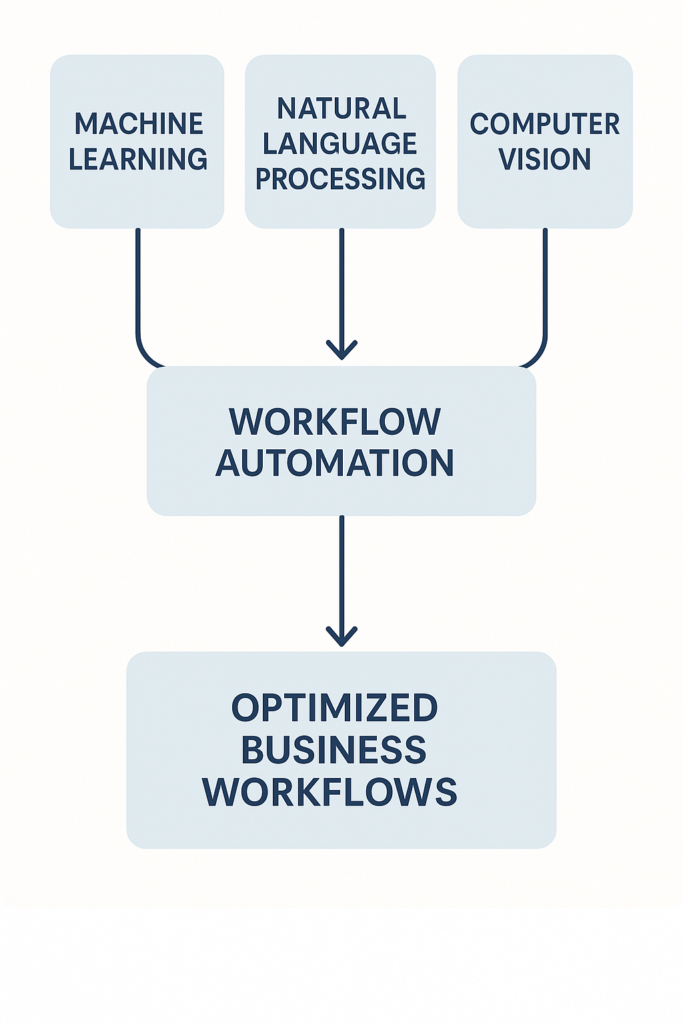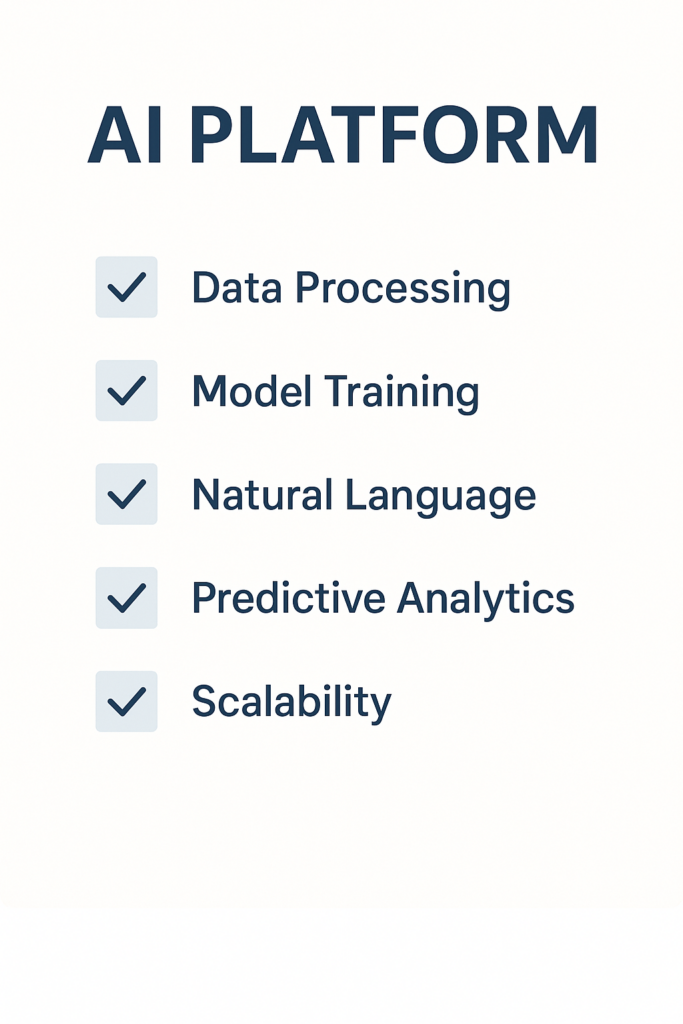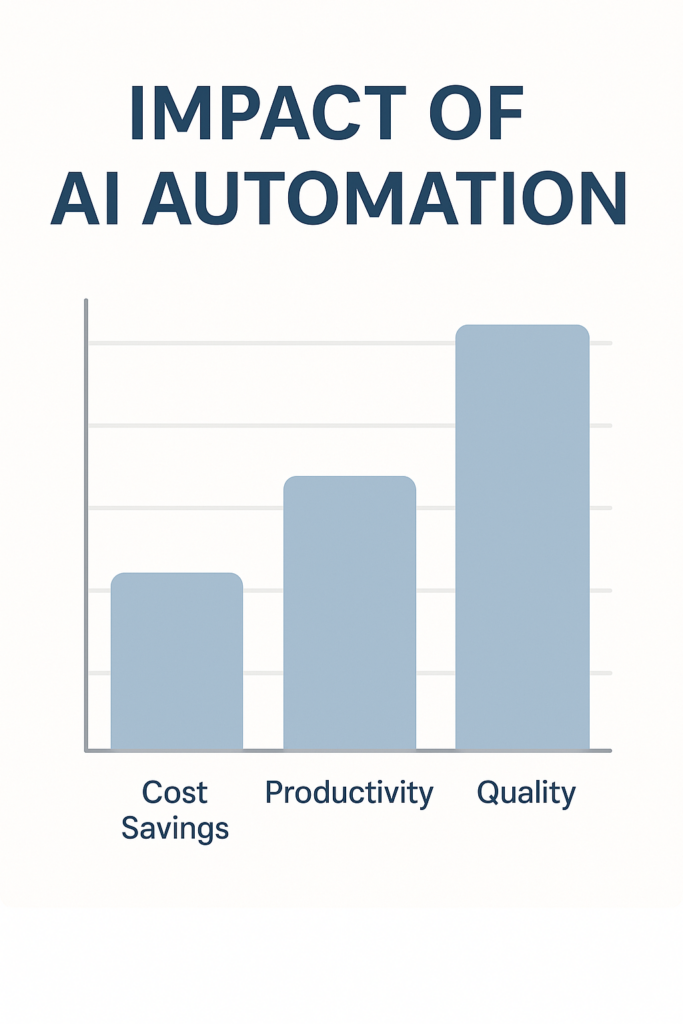What separates thriving enterprises from those struggling to keep pace in today’s digital-first landscape? The answer often lies in how effectively they harness AI-powered process automation platforms. These innovative solutions go beyond streamlining workflows—they improve decision-making, reduce human bias, and unlock new opportunities for scalability and growth.
From seamlessly integrating with legacy systems to delivering measurable returns on investment, AI automation is transforming industries. However, success stories go beyond efficiency alone; they highlight how organizations are accelerating digital transformation and gaining a competitive edge.
Let’s dive into real-world examples of enterprise AI automation successes and uncover actionable insights to guide your transformation journey.
Key Takeaways
- Decision Quality Enhancement: AI automation platforms significantly improve decision-making by reducing human bias and leveraging data-driven insights, enabling more objective and accurate business decisions.
- Enterprise Integration Benefits: Successful implementation of AI automation delivers seamless integration with legacy systems while maintaining security protocols and compliance standards.
- ROI Measurement Framework: Enterprise-level AI automation implementations demonstrate measurable returns through reduced operational costs, improved efficiency, and enhanced customer satisfaction metrics.
- Cross-Industry Applications: AI automation platforms show versatility across various sectors, with customizable solutions that address industry-specific challenges and regulatory requirements.
- Digital Transformation Impact: Organizations implementing AI automation report accelerated digital transformation timelines and improved competitive positioning in their respective markets.
- Advanced Capabilities: Modern AI automation platforms combine machine learning, natural language processing, and workflow optimization to deliver superior results compared to traditional RPA solutions.
- Change Management Success: Enterprise-wide adoption of AI automation requires strategic change management approaches to address employee concerns and ensure smooth implementation.
- Scalability Features: Leading AI automation platforms offer flexible scaling options that grow with enterprise needs while maintaining performance and efficiency.
- Security Integration: Robust security measures and compliance frameworks are built into enterprise AI automation solutions, protecting sensitive data throughout the automation process.
AI-powered process automation platforms are transforming how enterprises handle complex workflows, decision-making processes, and operational efficiency. These sophisticated systems combine artificial intelligence capabilities with traditional automation to create intelligent solutions that can learn, adapt, and handle complex business scenarios with minimal human intervention. Let’s explore how these platforms are revolutionizing enterprise operations and what decision-makers need to know when considering implementation.
Definition and Key Features of AI-Powered Process Automation Platforms

AI-powered process automation platforms are comprehensive software solutions that combine artificial intelligence technologies with workflow automation capabilities to streamline business processes. Unlike traditional automation tools that follow rigid rules, these platforms can understand, learn from, and adapt to changing business conditions.
At their core, these platforms integrate several AI technologies:
- Machine learning algorithms that analyze patterns in data and improve performance over time without explicit programming
- Natural language processing capabilities that enable systems to understand and generate human language
- Computer vision technologies that allow platforms to interpret and process visual information from documents, images, and videos
These platforms typically include workflow designers, integration tools, analytics dashboards, and AI model management components. The workflow designers allow business users to map out processes visually, while integration tools connect with existing enterprise systems. Analytics dashboards provide insights into process performance, and AI model management components handle the training and deployment of machine learning models.
What sets these platforms apart is their ability to handle unstructured data and make decisions based on contextual information. They can extract information from emails, documents, and images, understand the content, and take appropriate actions based on that understanding. This makes them particularly valuable for processes that involve variable inputs and complex decision-making.
AI Automation vs. Traditional RPA
While AI automation platforms and traditional robotic process automation (RPA) both aim to reduce manual work, they differ significantly in capabilities, application areas, and long-term value.
Traditional RPA excels at automating rule-based, repetitive tasks with structured data. These tools follow predefined instructions and work best when processes are stable and exceptions are minimal. They essentially mimic human actions at the user interface level, clicking buttons, entering data, and transferring information between systems.
In contrast, AI-powered automation platforms can:
- Handle unstructured data from multiple sources
- Make decisions based on probability and context using fuzzy logic
- Learn from new scenarios and improve over time
- Process natural language and understand intent
- Adapt to process variations without reprogramming
For example, while RPA might automate data entry from standardized forms, AI automation can extract information from varied document formats, understand the context, identify missing information, and make decisions about how to process exceptions.
The distinction becomes particularly important for complex processes that require judgment. AI automation can evaluate multiple factors, weigh different options, and select the most appropriate action based on learned patterns and business rules. This capability allows organizations to automate more sophisticated workflows that previously required human decision-making.
Integration and Scalability of AI Automation Platforms
Modern AI-powered process automation platforms are designed with integration and scalability as fundamental principles. These platforms connect seamlessly with existing enterprise systems through various methods, creating a unified automation ecosystem.
Integration capabilities typically include:
- RESTful APIs and web services for connecting with cloud applications
- Native connectors for popular enterprise systems like SAP, Salesforce, and Microsoft 365
- Database connectors for direct data access and manipulation
- RPA capabilities for legacy system integration where APIs aren’t available
- Event-based triggers that respond to changes across the technology stack
This connectivity allows AI automation to work across departmental boundaries, creating end-to-end process automation that spans multiple systems and data sources.
The cloud-native architecture of leading platforms provides significant scalability advantages. Organizations can start with specific use cases and expand as needed without major infrastructure investments. Cloud deployment models offer:
- Elastic computing resources that adjust to processing demands
- Distributed processing for handling large volumes of transactions
- Multi-tenant architectures that support enterprise-wide deployment
- Global availability for supporting international operations
This scalability is particularly valuable for enterprises with fluctuating workloads or growth plans. The ability to scale automation initiatives without proportional increases in cost or complexity accelerates digital transformation efforts and improves return on investment.
Advanced Decision-Making and Adaptive Learning
AI-powered process automation platforms transform decision-making by applying sophisticated algorithms to business processes. These systems analyze multiple data points, consider various factors, and make decisions based on both predefined rules and learned patterns.
The decision-making capabilities include:
- Predictive analytics that forecast outcomes based on historical data
- Classification algorithms that categorize items based on multiple attributes
- Recommendation engines that suggest optimal actions
- Anomaly detection that identifies unusual patterns requiring attention
- Natural language understanding that interprets intent from text
A financial services company implemented AI automation for loan processing and saw a 60% reduction in processing time while improving decision accuracy by 25%. The system analyzed applicant data, credit histories, and market conditions to make consistent, data-driven lending decisions.
What makes these platforms particularly powerful is their adaptive learning capability. They continuously improve by:
- Monitoring outcomes of automated decisions
- Identifying patterns in successful and unsuccessful processes
- Incorporating feedback from human reviewers
- Adjusting decision parameters based on changing conditions
- Learning from new examples and edge cases
This continuous learning creates a virtuous cycle where machine learning models become more accurate over time, handling increasingly complex scenarios with greater confidence. The result is automation that becomes more valuable the longer it runs, unlike traditional systems that require manual updates to improve.
Applications and Use Cases Across Industries
AI-powered process automation platforms are transforming operations across diverse industries, with each sector finding unique applications that address specific challenges and opportunities.
In financial services, these platforms handle:
- Intelligent document processing for loan applications and claims
- Anti-fraud detection systems that identify suspicious patterns
- Automated compliance checks against changing regulations
- Customer onboarding workflows with identity verification
A global bank implemented AI automation for its know-your-customer (KYC) process, reducing processing time from days to minutes while improving accuracy and compliance.
Healthcare organizations apply these technologies to:
- Patient intake and insurance verification
- Clinical documentation analysis and coding
- Care coordination workflows across providers
- Revenue cycle management and claims processing
Manufacturing companies leverage AI automation for:
- Predictive maintenance scheduling
- Quality control with computer vision
- Supply chain optimization and inventory management
- Product design and engineering workflows
Retail and e-commerce businesses implement:
- Personalized marketing automation
- Inventory forecasting and replenishment
- Returns processing and customer service automation
- Pricing optimization based on market conditions
The versatility of AI process automation examples across industries demonstrates how these platforms can be tailored to specific business contexts while leveraging common AI capabilities like document understanding, decision-making, and predictive analytics.
Key Features to Look for in AI Automation Platforms

When evaluating AI-powered process automation platforms, decision-makers should focus on capabilities that align with their strategic objectives and technical requirements.
Essential platform capabilities include:
- Intelligent document processing that can extract, classify, and validate information from various document types
- Process mining and discovery tools that identify automation opportunities and process inefficiencies
- Low-code/no-code development environments that enable business users to create and modify workflows
- Pre-built AI models for common business functions that reduce implementation time
- Custom AI model development capabilities for organization-specific needs
ROI optimization features are particularly important:
- Process analytics dashboards that track performance metrics
- A/B testing capabilities for comparing automation approaches
- Simulation tools that predict outcomes before deployment
- Value tracking that quantifies time and cost savings
Governance and compliance capabilities should include:
- Comprehensive audit trails of all automated actions
- Role-based access controls for security
- Explainable AI features that document decision rationales
- Compliance frameworks for industry-specific regulations
- Data privacy controls and information security measures
Integration capabilities are critical for success:
- API management tools for connecting with enterprise systems
- Pre-built connectors for common business applications
- Support for both cloud and on-premises deployment
- Integration with existing RPA investments
The right platform should balance sophisticated AI capabilities with practical implementation considerations, ensuring both technical excellence and business value.
Implementing AI Automation for Improved Business Processes
Successful implementation of AI-powered process automation platforms requires a structured approach that balances technical considerations with organizational change management.
The implementation journey typically follows these steps:
- Process assessment and selection: Identify high-value processes with clear ROI potential, considering factors like volume, complexity, and strategic importance.
- Process documentation and optimization: Map current workflows, identify inefficiencies, and redesign processes before automation.
- Data preparation: Ensure data quality, accessibility, and appropriate governance for AI training and operation.
- Platform selection: Choose the right AI automation platform based on specific requirements and use cases.
- Proof of concept: Test the solution with a limited scope to validate assumptions and demonstrate value.
- Iterative development: Build automation solutions incrementally, gathering feedback and refining approaches.
- Testing and validation: Verify accuracy, performance, and compliance before full deployment.
- Deployment and monitoring: Roll out the solution and establish ongoing performance tracking.
- Continuous improvement: Refine models and processes based on operational data and changing requirements.
Change management is critical for successfully implementing AI process automation. Organizations should:
- Communicate the purpose and benefits of automation clearly
- Involve process owners and users in the design phase
- Provide training on new tools and changed responsibilities
- Create centers of excellence to share best practices
- Establish governance frameworks for managing automation initiatives
A phased implementation approach allows organizations to build momentum with early wins while developing the skills and experience needed for more complex automation projects. This approach also helps manage change at a pace the organization can absorb.
Top AI Automation Tools and Platforms in the Market
The market for AI-powered process automation platforms includes a diverse range of solutions with varying strengths and specializations. Understanding the landscape helps organizations select platforms that align with their specific requirements.
Leading enterprise-grade platforms include:
- IBM Automation Platform: Offers comprehensive capabilities, including document processing, workflow automation, and decision management with strong enterprise integration.
- Microsoft Power Automate: Provides accessible AI automation that is tightly integrated with Microsoft 365 and Azure services and has strong low-code capabilities.
- UiPath: Combines traditional RPA strengths with expanding AI capabilities for document understanding and process mining.
- Automation Anywhere: Features IQ Bot for cognitive automation and strong cloud-native architecture.
- Appian: Offers process automation with integrated low-code application development and case management.
Specialized platforms focus on specific aspects of AI automation:
- WorkFusion: Emphasizes intelligent document processing and learning automation for financial services and healthcare.
- Kofax: Specializes in document-centric workflows with strong capture and processing capabilities.
- Celonis: Focuses on process mining and intelligence to identify automation opportunities.
- ABBYY: Excels in document understanding and natural language processing.
When selecting platforms, organizations should consider:
- Alignment with specific use cases and industry requirements
- Integration capabilities with existing systems and data sources
- Total cost of ownership, including licensing, implementation, and maintenance
- Vendor stability and roadmap for future development
- Available support services and partner ecosystem
- Security and compliance certifications relevant to the industry
Many organizations implement multiple complementary tools rather than seeking a single platform for all automation needs. This best-of-breed approach allows them to leverage specialized capabilities while maintaining an integrated automation strategy.
How AI Automation Enhances Decision-Making Quality
AI-powered process automation platforms transform decision-making by combining data analysis, pattern recognition, and business rules to produce consistent, high-quality decisions at scale.
These platforms enhance decision quality through several mechanisms:
- Data-driven insights: Analyzing larger volumes of data than humans can process to identify patterns and relationships
- Reduced cognitive bias: Making decisions based on objective criteria rather than subjective judgments
- Consistent application of rules: Applying the same decision criteria across all cases
- Contextual understanding: Considering multiple factors and their relationships when making decisions
- Continuous learning: Improving decision models based on outcomes and feedback
A healthcare provider implemented AI automation for patient triage and saw a 35% improvement in appropriate care level assignment while reducing wait times by 40%. The system analyzed symptoms, medical history, and available resources to make optimal triage decisions.
In financial services, AI workflow automation has transformed credit decision-making by:
- Incorporating alternative data sources beyond traditional credit scores
- Detecting subtle patterns that indicate risk or opportunity
- Adapting to changing market conditions in near real-time
- Providing consistent decisions while reducing processing time from days to minutes
For complex decisions, these platforms often implement a human-in-the-loop approach where:
- AI handles routine cases with high confidence
- Borderline cases are flagged for human review with supporting information
- Human decisions are fed back to the system for continuous improvement
This collaborative approach combines the efficiency and consistency of AI with human judgment for exceptional cases, creating a decision-making system that exceeds the capabilities of either humans or machines working independently.
Ensuring Successful Implementation of AI Automation
Implementing AI-powered process automation platforms successfully requires addressing common challenges and establishing the right organizational foundations.
Key implementation challenges include:
- Data quality and accessibility: AI systems require clean, accessible data for training and operation
- Integration complexity: Connecting with legacy systems and ensuring data flows across platforms
- Skills gaps: Finding talent with both process expertise and AI implementation knowledge
- Change resistance: Overcoming organizational reluctance to adopt new ways of working
- Governance uncertainty: Establishing appropriate oversight for automated decisions
Successful organizations address these challenges by:
- Starting with data preparation and governance before automation
- Creating cross-functional teams that combine business and technical expertise
- Developing internal capabilities through training and partnerships
- Communicating clear value propositions for all stakeholders
- Establishing governance frameworks that balance innovation with control
A manufacturing company overcame initial resistance by creating a joint business-IT automation team and demonstrating quick wins that reduced manual work while improving quality. They started with processes that caused employee frustration, positioning automation as a tool to eliminate tedious tasks rather than replace jobs.
Security and compliance considerations are particularly important:
- Implementing appropriate access controls and data protection
- Ensuring audit trails for automated decisions
- Addressing regulatory requirements for explainability
- Establishing testing protocols for AI models before deployment
- Creating monitoring systems to detect and address issues
Organizations that transform businesses with enterprise AI automation services most successfully view implementation as a continuous journey rather than a one-time project, establishing feedback loops and improvement mechanisms from the start.
Achieving Long-Term ROI with AI Automation

Maximizing return on investment from AI-powered process automation platforms requires a strategic approach to measurement, optimization, and expansion.
Effective ROI measurement includes:
- Direct cost savings: Reduced labor costs, error remediation, and processing time
- Productivity improvements: Increased throughput and capacity without additional resources
- Quality enhancements: Reduced errors, improved compliance, and consistent outcomes
- Revenue impacts: Faster processing leading to improved customer experience and retention
- Strategic benefits: Improved agility, scalability, and competitive positioning
Organizations should implement measurement systems that track these metrics before, during, and after automation implementation to quantify the full value delivered.
Optimization strategies to maximize ROI include:
- Continuous monitoring of automation performance with analytics dashboards
- Regular review and refinement of AI models to improve accuracy
- Process mining to identify additional automation opportunities
- Expanding automation scope to include upstream and downstream processes
- Reusing components and models across multiple automation initiatives
A retail organization initially automated customer service inquiries and achieved a 40% cost reduction. By analyzing the patterns in customer interactions, they identified additional automation opportunities in inventory management and personalized marketing, expanding their ROI significantly.
Long-term value creation strategies include:
- Building an automation center of excellence to share best practices
- Creating reusable automation components and AI models
- Developing internal capabilities through training and knowledge transfer
- Establishing governance frameworks that balance innovation with control
- Integrating automation with broader digital transformation initiatives
Organizations that achieve the highest ROI view AI automation as a strategic capability rather than a tactical solution, continuously expanding its application while refining their approach based on results and lessons learned.
Future Trends in AI Process Automation
The landscape of AI-powered process automation platforms continues to evolve rapidly, with several emerging trends shaping the future of enterprise automation.
Hyperautomation is expanding the scope of automation by:
- Connecting previously siloed automation initiatives into integrated ecosystems
- Combining multiple technologies (RPA, AI, process mining, low-code) in unified platforms
- Extending automation across organizational boundaries to partners and customers
- Creating end-to-end automated processes that span departments and systems
Cognitive process mining is transforming how organizations discover automation opportunities:
- Automatically identifying process inefficiencies and bottlenecks
- Suggesting process improvements based on data analysis
- Continuously monitoring processes to detect changes and drift
- Quantifying the potential value of specific automation initiatives
Autonomous decision intelligence frameworks are emerging that:
- Make complex decisions with minimal human intervention
- Adapt to changing conditions in real-time
- Explain their reasoning and provide confidence levels
- Learn from outcomes to improve future decisions
Human-AI collaborative workflows are becoming more sophisticated:
- AI systems that understand when to involve humans in decisions
- Interfaces designed for effective human-AI collaboration
- Systems that learn from human experts to improve automation
- Augmented intelligence tools that enhance human capabilities
Explainable AI for regulatory compliance is addressing transparency concerns:
- Tools that document decision rationales in human-understandable terms
- Audit capabilities that track model inputs and outputs
- Bias detection and mitigation frameworks
- Governance systems that ensure appropriate oversight
Organizations planning their automation strategy should consider these trends when selecting platforms and designing their approach, ensuring they build capabilities that will remain relevant as the technology landscape evolves.
Conclusion
AI-powered process automation platforms represent a transformative technology that goes beyond traditional automation to create intelligent, adaptive systems capable of handling complex business processes. These platforms combine the efficiency of automation with the intelligence of AI to deliver significant improvements in operational performance, decision quality, and business agility.
As organizations navigate their digital transformation journeys, AI automation provides a powerful tool for addressing efficiency challenges while creating new capabilities. The most successful implementations combine technology with organizational change management, focusing on both the technical aspects of implementation and the human factors that determine adoption and value realization.
Looking ahead, the continued evolution of AI capabilities promises even greater potential for automation to transform business operations. Organizations that establish strong foundations now, with appropriate governance, skills development, and strategic alignment, will be well-positioned to leverage these advances and maintain a competitive advantage.
For organizations ready to explore how AI automation can transform their operations, the first step is a thorough assessment of current processes, pain points, and strategic objectives. This foundation enables the selection of appropriate technologies and implementation approaches that align with specific business needs and deliver measurable value.
References
**
Frequently Asked Questions
AI-powered automation acts as a digital co-pilot, merging machine learning with rule-based workflows to transform repetitive tasks into dynamic, self-improving systems. At its core, it’s about teaching software to learn from patterns—whether processing invoices, routing customer service queries, or predicting inventory needs. Key elements include:
- Cognitive document processing that extracts data from emails, PDFs, and handwritten notes, reducing manual entry errors
- Adaptive decision-making where algorithms adjust workflows in real-time based on new data inputs
- Cross-platform orchestration that syncs CRM, ERP, and legacy systems without human middleware
Platforms like Automation Anywhere now integrate NLP to handle unstructured data, while UiPath’s AI-driven bots learn from user corrections, achieving 90 %+ accuracy in complex tasks according to industry benchmarks.
Think of these platforms as Swiss Army knives for enterprise efficiency—they combine robotic process automation (RPA), machine learning, and predictive analytics in a single interface. Bizagi’s low-code environment, for instance, lets teams drag-and-drop AI modules that automatically parse contracts or flag compliance risks. Core capabilities include:
- Unified process intelligence that maps end-to-end workflows while identifying automation sweet spots
- Self-healing automation where bots troubleshoot issues like changed UI elements without human intervention
- Democratized development through visual builders and pre-trained AI models accessible to non-technical users
Blue Prism’s recent updates introduced AI-driven process mining that reduces automation discovery phases from weeks to hours, according to their 2025 enterprise case studies.
The “best” depends on whether you’re optimizing for scale, precision, or accessibility. For enterprises needing bulletproof security, Blue Prism offers military-grade encryption and detailed audit trails. Lean teams often prefer Nintex’s all-in-one suite that handles RPA, e-signatures, and document automation through a single portal. Critical considerations:
- Pre-built industry templates like UiPath’s healthcare claims processor or Automation Anywhere’s retail inventory optimizer
- AI skill level requirements—Bizagi requires minimal coding, while open-source frameworks demand ML expertise
- Hybrid deployment options balancing cloud scalability with on-premises data governance
2025 benchmarks show UiPath customers automating 500+ processes simultaneously, with error rates dropping below 2% in high-volume transactions.
Imagine a self-optimizing assembly line where each robot learns from the last shift’s mistakes. AI process automation begins by ingesting historical data to model “as-is” workflows, then applies reinforcement learning to simulate improvements. Nintex’s platform, for example, uses computer vision to monitor user interactions, automatically generating automation blueprints. Key mechanisms:
- Process discovery engines that analyze user activity logs to identify repetitive sub-tasks
- Digital twin simulations test hundreds of automation scenarios before deployment
- Closed-loop feedback where ML models retrain weekly using production performance data
A manufacturing firm using Automation Anywhere’s cognitive bots reduced invoice processing time from 14 minutes to 47 seconds in a 2024 implementation documented on their platform.
Any Other Questions?
That wraps up the most popular questions we get, but fire away with any others!
Contact us to discuss your next development project!
FAQ References
zapier.com/blog/best-ai-productivity-tools/
moveworks.com/us/en/resources/blog/best-ai-automation-tools-for-efficiency
flowforma.com/blog/ai-automation-examples
appian.com/blog/acp/ai/Automation-Using-AI
advsyscon.com/blog/process-automation-tools/

